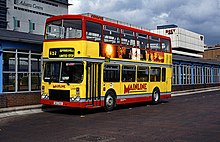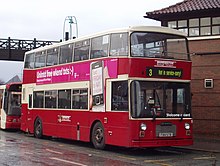Dennis Dominator
| Dennis Dominator | |
|---|---|
Dennis Arrow |
The Dennis Dominator was Dennis's first rear-engined double-decker bus chassis, it was launched in 1977.
History





Dennis had been absent from the bus manufacturing market since the last Lolines were produced in 1967. The Dominator was described as bespoke, with numerous options. To some extent it was considered a successor to the Daimler/Leyland Fleetline.
The Dominator was different from the Fleetline in that the radiator was located at the front instead of the offside of the engine compartment.
It was intended to be sold mainly with the
United Kingdom
The largest British customer of the Dennis Dominator was
The SYPTE Dominators were delivered in phases to replace Daimler Fleetlines, Leyland Atlanteans, Volvo Ailsa B55s, some of which dated to the early 1970s. The final batch of Dominators delivered to Sheffield included 20 vehicles fitted with coach seats and were allocated to regionwide express services with distinctive Fastline branding. The high standard of engineering led to the last Dominators in South Yorkshire remaining in service in Doncaster until July 2006.
The Dominator also appealed to
Production of the Dominator was less consistent after
Single-deck Dominators
This section may be too long to read and navigate comfortably. (February 2022) |
The Dominator was conceived as a competitor to the Daimler Fleetline and initially customers were generally those who had previously taken double-deck Fleetlines, however the largest component of the all-single deck Darlington Corporation fleet was the single-deck Fleetline SRG6, the rest of its parc in 1977 consisted of 1967 Daimler Roadliners, new Leyland Leopards and 1974 Seddon Pennine RU. So, in 1978, it ordered a single-deck version of the Dominator with an extended-wheelbase, designed for 11-metre coachwork, this was bodied by Marshall and the style, dual door with 46 seats, when exhibited on the Dennis stand at the 1978 Motor Show at the National Exhibition Centre was named Camair 80.
David Cox, then Engineering Director of Merseyside PTE, reviewed it under his alias Midlander for Buses. He commented that the design was nothing like as stylish, but probably cheaper to produce than the original Marshall Camair. He felt that the side-facing bench seats over the front wheel arches, with their deep footstools, gave a rather tunnel-like aspect, and offered his ideas on a tidier layout, but praised the principle of using the same chassis for double and single-deck applications.[7] Darlington took a further nine in the following year. Dennis designated all ten of these SD103A. They were the only customer to place a repeat order (in 1981) for eight outwardly identical vehicles coded SD128A.[8] Darlington's next purchase was to be the only batch of Ward Motors Dalesman GRXI in 1984.
The next customer was the borough of
A number of chief engineers working for operators in the North of England met regularly at the time at gatherings sponsored by the Traffic Commissioner, as well as
The fourth customer was Merthyr Tydfil Transport, another all single-deck fleet, like Hartlepool, no Fleetlines were operated. The fleet consisted of East Lancs-bodied Leopards, Bristol REs with East Lancs and Eastern Coach Works bodies, Leyland Nationals and a batch of Metro-Scanias. Hartlepools single-deck Dominators had its first East Lancs bodies, Merthyr Tydfil's their first Marshall bodies. Their six (coded SD116) had single-door 50 seat Camair 80 coachwork. Like Hartlepool Leyland National 2s followed.[13] Later in life, these buses were sold to the City of Chester, whose General Manager had previously worked at Darlington.
The penultimate customer took their single-deck Dominator, the sole SD130A, some months after the final new customer's batch was delivered but this was no surprise as the job involved was a lot more complex than a bus body. EBB846W was to the bespoke specification of the
The final customer for the single-deck Dominator were a fleet who had Fleetlines, but only double-deckers, this was
Only 37 single-deck Dominators were built, all but the show bus in 1979-81. None are known to survive. The Camair 80 body also went on four 1970 Fleetlines for Tayside, Strathclyde PTE's single deck Ailsa, a number of Dennis Falcons and in a unique demountable-body version on Dodge Commando, again for Strathclyde PTE.
G.G. Hillditch, who had been one of the inspirations behind the Dominator and, at the time as General Manager of Leicester City Transport, was the launch customer for the type, had earlier (when General Manager of the Halifax Corporation, Halifax Joint Committee and Todmorden Joint Committee fleets) been one of the customers requesting the SRG6 Fleetline single-decker, but when Leicester required further single deckers from 1980 instead of ordering the Dominator he commissioned the Dennis Falcon H.[14]
Export orders

The Dominator was also sold to Hong Kong. China Motor Bus put the first Dominator (with East Lancs body) into service in 1979, being followed by six with Alexander RL-type body in 1982, primarily for its route 15 (Central-The Peak). Kowloon Motor Bus bought 40 Duple Metsec bodied Dominators between 1983 and 1984.[15][16]
One Dominator with
End of production
After a production run of 1,007 examples for the UK and export markets, the Dominator was replaced by the short-lived longitudinal-engined
Dominator variants
Dennis Falcon
In 1980, Dennis developed the Falcon single-deck bus with longitudinally-mounted rear engine. The Falcon H variant had a horizontal Gardner engine with the Voith gearbox mounted ahead of the rear axle,[18] the later Falcon HC had the Voith transmission mounted behind the rear axle and close-coupled to the Gardner engine. The Falcon V variant had vertical engines.[19]
Dennis Dragon/Condor
In 1982, a tri-axle version was developed for the Hong Kong market, known as the Dennis Dragon which was sold to Kowloon Motor Bus. The same model was sold to China Motor Bus, but was known as the Condor. They were usually bodied by Duple Metsec. Some were purchased by Stagecoach for its Kenyan and Malawi operations.
Some of these were repatriated to the UK through dealer Ensignbus. They are used for school runs and sightseeing since they have high-capacity.
Dennis Domino
In 1984, Dennis introduced a midibus chassis which was a scaled down Dominator, it could be fitted with Perkins T6.354 and Avon Maxwell transmission.
It was only sold to two customers,
References
- ^ Dominator unveiled Commercial Motor 2 September 1977
- ^ Alternative power Commercial Motor 27 September 1980
- ^ a b c d "Dominator makes way for the lighter Lance". Coach & Bus Week. No. 214. Peterborough: Emap. 20 April 1996. p. 31.
- ^ "LT's off-the-peg buses". Commercial Motor. Temple Press. 30 July 1983. Retrieved 31 August 2021.
- ^ "Volvo deckers arrive in London". Commercial Motor. Temple Press. 16 June 1984. Retrieved 31 August 2021.
- ^ Dennis Dominators for London Pride
- ^ Midlander (1978). Parke (ed.). "Maybe We'll Get it Right Next Time..?". Buses (285). Shepperton: 535, 536.
- ^ "Dennis - Dominator". Bus Lists on the Web. SD128A/208.
- ^ "Dennis - Dominator". Bus Lists on the Web. SD115/154.
- ^ Cox (2009). Stenning (ed.). "A Committee is formed". Classic Bus (99). London: 34.
- ^ "Dennis - Dominator". Bus Lists on the Web. SD115/156.
- ^ Parke, ed. (1980). "Norris Barrow Diamond Jubilee". Buses Extra (15). Shepperton: 37.
- ^ Booth (1983). The British Bus Today and Tomorrow. Shepperton. p. 78.
{{cite book}}: CS1 maint: location missing publisher (link) - ^ Hillditch (1981). A Further Look At Buses. Shepperton. pp. 99–102.
{{cite book}}: CS1 maint: location missing publisher (link) - ^ Kowloon buys British Commercial Motor 30 October 1982
- ^ a b "Hong Kong Buses Part 3: Kowloon Motor Bus" Fleetline issue 249 July 1997 page 118
- ISBN 9781900515269.
- ^ Morris (1981). Morris (ed.). "Dennis in 1981". Buses (317). Shepperton: 348, 349.
- ^ Morris (2005). Booth; Morris (eds.). "Dominating No More". Buses Focus (35). Hersham: 40–45.
External links
![]() Media related to Dennis Dominator at Wikimedia Commons
Media related to Dennis Dominator at Wikimedia Commons
